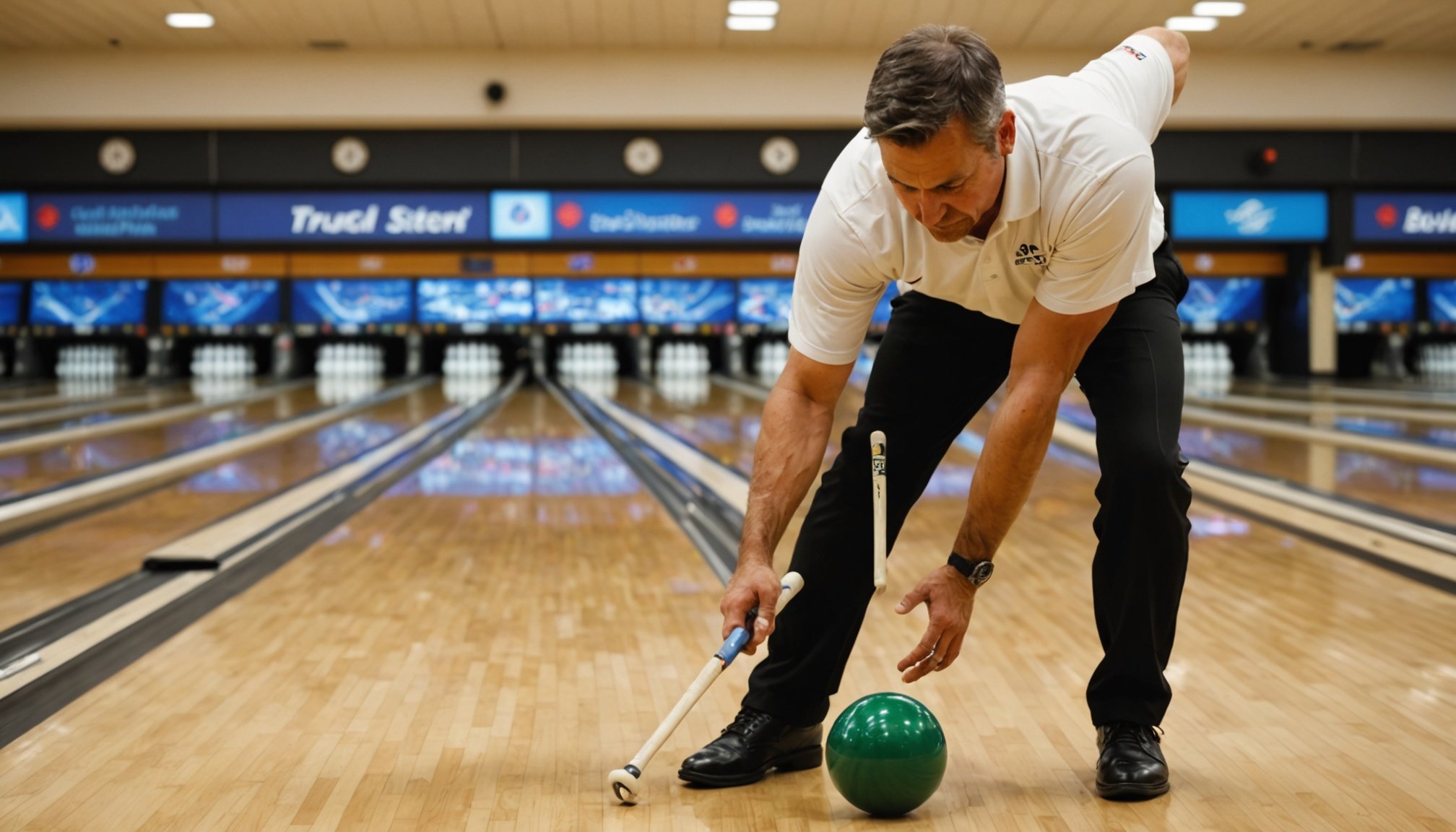Understanding Lower Back Pain in Bowlers
Lower back pain is a prevalent issue among bowlers, often resulting from repetitive movements and strain associated with the sport. The physical demands of bowling, including bending, twisting, and swinging, make the lower back particularly susceptible to stress and injury. Understanding the common causes of pain in this context is crucial for prevention and management.
Among the primary causes of pain in bowlers are improper techniques and inadequate preparation. Incorrect posture during delivery or excessive force can lead to muscle strain or even spinal injuries. Additionally, a lack of sufficient warm-up exercises can exacerbate these risks, leaving the lower back vulnerable to stress.
Additional reading : Elevate your golf performance: the definitive strength training blueprint for hitting longer drives
Bowling techniques significantly impact back health. Techniques that involve abrupt stops or excessive twisting motions increase the risk of injury. Maintaining a consistent form can help mitigate this. Proper footwear and equipment also play a role in reducing the strain on the lower back, as they support balance and posture during play. By focusing on refining techniques and adopting preventative measures, bowlers can minimise the risks of injury and enjoy the sport comfortably.
Importance of Proper Bowling Posture
In the engaging world of bowling, proper posture is not just a recommendation—it’s a necessity for enhancing performance and ensuring injury prevention. Establishing a solid foundation in your bowling posture involves understanding key elements. First, maintain an upright stance with feet shoulder-width apart, which facilitates better alignment and stability. Your knees should be slightly bent to absorb impact, and your shoulders relaxed for fluid arm movement.
Have you seen this : Conquer tough terrain: top strategies to enhance endurance and strength for mountain bikers
Poor posture can lead to numerous back health issues. An incorrect distribution of weight impacts spinal alignment, potentially leading to strain or chronic pain. To avoid back problems, bowlers must focus on alignment. Engaging core muscles will help maintain balance and stability.
There are various techniques designed to support a bowler’s alignment and improve their game. Visualise a straight line from your head down to your heels, which aids in maintaining the right form. Employ regular checks during practice to self-correct any deviations in your stance. In prioritising these techniques, bowlers can find success while safeguarding their physical well-being.
Effective Warm-Up Routines for Bowlers
Bowling may seem leisurely, but to enhance performance and ensure injury prevention, a warm-up routine is crucial. Often overlooked, proper warm-up exercises prepare the body for the demands of bowling, particularly by enhancing flexibility and muscle efficiency.
Importance of a Warm-Up Routine
Engaging in a comprehensive warm-up routine before bowling reduces risks of strains and injuries. It boosts circulation, elevating muscle temperature and elasticity, readying you for action efficiently. This proactive step not only fortifies performance but prolongs your bowling career.
Suggested Dynamic Stretches
Dynamic stretching is essential, especially focusing on the muscles predominantly used in bowling, like the shoulders and arms. Perform arm circles and torso rotations to activate these muscles. Stretch your legs too; leg swings can be beneficial, promoting overall balance and flexibility. This is key to injury prevention.
Specific Warm-Up Exercises for Lower Back
Bowlers often encounter lower back stress due to repeated bending and twisting motions. Incorporate specific exercises like the cat-cow stretch or hip flexor stretch. These not only increase flexibility but also bolster the core, mitigating the risk of back-related injuries. Properly priming the lower back allows for smoother, more controlled bowling actions.
Strengthening Exercises for Lower Back Support
Maintaining a strong core is crucial for enhancing bowling performance and minimising lower back pain. Core stability exercises are designed to improve the muscles that support the spine and pelvis, ensuring a powerful and accurate bowling action. Exercises such as planks, Russian twists, and leg raises can significantly contribute to a bowler’s strength training regimen. These exercises are not just beneficial for performance; they play a pivotal role in injury prevention.
In tandem with core exercises, leg and hip strength is essential for sustaining lower back health. Strengthening these areas helps in distributing the physical load more evenly across the body, reducing undue stress on the lower back. Squats and lunges are excellent back exercises that target these areas, enhancing overall stability and strength.
For a comprehensive strength training programme tailored to bowlers, consider incorporating a mix of core exercises and lower body workouts. A routine that includes 10-15 minutes of core work followed by leg and hip exercises twice a week can greatly enhance your bowling performance. Regularly updating and modifying your programme ensures continued progress and adaptation.
Techniques for Reducing Strain While Bowling
Bowling necessitates an understanding of specific technique adjustments to minimise strain. One effective way to achieve this is by making careful modifications to reduce impact during delivery. Small changes, such as adjusting your stance or grip, can significantly reduce the stress on your back. For instance, maintaining a relaxed grip ensures less tension throughout the swing.
The significance of follow-through cannot be overstated. Follow-through techniques are essential for reducing tension in your back. When you complete your swing, ensure a fluid motion that allows your body to release energy naturally. This practice helps prevent abrupt stops that may lead to discomfort or injury.
Balancing speed and control is crucial for the health of your back. Striking a balance between these elements involves not only generating sufficient momentum but also managing that power effectively. Consider focusing on a smooth, controlled delivery to shield yourself from unwanted strain. Implementing these adjustments can sustain your bowling techniques, ensuring longevity and enjoyment in this spirited activity. These practical tips, when applied, will undoubtedly foster enhanced comfort and performance on the lanes.
Recognizing and Responding to Pain
Understanding pain management is crucial for maintaining health, especially when dealing with potential injuries. Recognizing the signs that indicate a serious injury or pain exacerbation is the first step. Symptoms such as persistent sharp pains, swelling, and inability to bear weight may suggest significant issues requiring attention. Identifying these signs allows for timely action, minimizing long-term consequences.
When you experience lower back discomfort, initial steps should be cautious and deliberate. Rest is vital; avoid activities that may aggravate the pain. Applying ice can reduce inflammation, while gentle stretching might alleviate tension. However, if the discomfort persists or worsens, these recovery strategies may not suffice.
In such cases, consulting a healthcare professional becomes essential. They can properly evaluate the injury, ensuring a comprehensive approach to pain management. Professionals may suggest therapies and exercises tailored to your condition, enhancing recovery efficacy. Understanding when to seek professional help is vital in preventing further damage and ensuring a safe, effective healing process. Embrace structured recovery strategies as part of a proactive approach to well-being.
Expert Insights and Testimonials
Understanding the complexities of back pain prevention in bowling requires expert advice. Professionals who have dedicated their careers to sports medicine stress the importance of proper techniques and regular stretching routines. By focusing on core strength, bowlers can significantly reduce the risk of lower back issues.
Seasoned bowlers offer invaluable personal experiences, showcasing how they’ve managed persistent back pain. For instance, many athletes emphasize the role of tailored exercise regimes. Regular consultations with physiotherapists allow them to maintain their peak performance without sacrificing their well-being.
Athlete testimonials further build credibility in these preventative strategies. Many success stories highlight simple yet effective adjustments, such as tweaking one’s stance or optimizing the follow-through motion. Incorporating these subtle changes has shown remarkable improvements over time.
Some bowlers attest to the benefits of investing in quality footwear, which offers enhanced support during play. Others find relief through regular yoga sessions, which enhance flexibility and resilience. By drawing from this wealth of shared knowledge, both experts and athletes empower newcomers to make informed choices, fostering a safer sporting environment.
Visual Aids and Resources
For those seeking to enhance their understanding of proper posture and exercises, incorporating visual aids like diagrams can be immensely beneficial. These resources not only provide clear illustrations but also serve as guideposts for achieving optimal results. By engaging with instructional videos, learners can gain step-by-step insights into warm-ups and techniques that are often difficult to grasp through text alone.
Instructional videos stand out as they demonstrate dynamic movements, offering viewers a comprehensive look at each exercise process. This immersive method aids in fostering a clearer understanding, thus encouraging correct practice.
Additionally, exploring a variety of educational resources can further solidify one’s knowledge base. These materials provide comprehensive insights that support readers in their educational journey. By seeking out varied reading materials, learners can ensure they have ample information to draw upon, reinforcing the practices highlighted in both diagrams and videos.
Ultimately, the combination of these resources equips learners with the necessary tools to refine their technique and commitment to personal improvement.
















